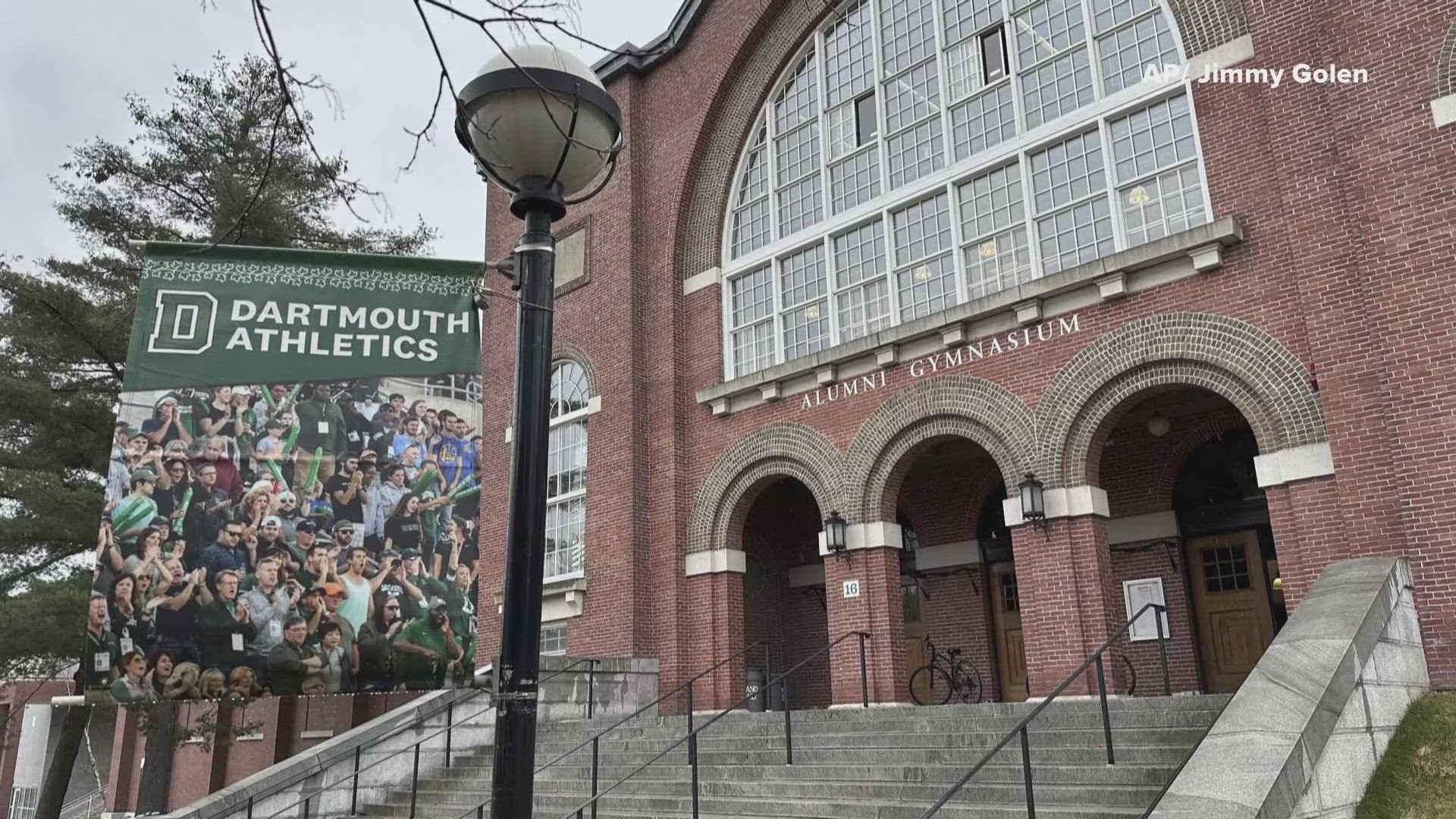HANOVER, N.H. — A ruling that gives the Dartmouth basketball team the right to unionize has far-reaching implications for all of college sports — from the quaint, academically oriented Ivy League to the big-money football factories like Michigan and Alabama.
The players voted 13-2 on Tuesday to form a union on the campus in Hanover, New Hampshire after a bid by the school to reopen the case was denied.
But it’s not time to cut down the nets just yet.
Although a recent ruling by a National Labor Relations Board official put the players on the path toward a union, they have a long way to go — years, maybe — before they would be able to sit down with the school and negotiate a collective bargaining agreement. The bid is being closely watched.
“We are excited to see how this decision will impact college sports nationwide,” Dartmouth players Cade Haskins and Romeo Myrthil said in a statement after NLRB Regional Director Laura Sacks agreed that they are employees of the school. “We believe that other athletes will recognize the opportunities this ruling presents and will be inspired to follow suit.”
Here is a look at what happened — and what’s next — in the fight for college athlete rights:
HOW DID WE GET HERE?
The NCAA has long maintained that college players are “student-athletes” — a term designed to perpetrate the pretense that education comes first. But in Power Five leagues like the Big Ten and Southeastern Conference, football is a billion-dollar business that looks more like the NFL than the glee club or other extracurricular activities on campus.
The amateur model is under attack on several fronts, including a 2021 Supreme Court ruling that opened the door for athletes to be paid; in response, the NCAA loosened rules to allow players to profit from their celebrity. The NCAA is also facing at least six antitrust lawsuits.
In a different NLRB proceeding, football and basketball players at Southern California say they are employees of the school, the Pac-12 Conference in which they play, and the NCAA. That hearing resumes later this month.
At Dartmouth and its Ivy League brethren, though, the “student-athlete” paradigm might actually be accurate.
Dartmouth doesn’t give out athletic scholarships, the school says the program loses money — the players dispute that — and athletes are expected to prioritize their academic responsibilities before sports. The school says playing on the basketball team is not a job; it's like participating in the orchestra or Model United Nations.
But the players argued that the school exerts enough control over them to make them employees, and Sacks agreed.
“Because Dartmouth has the right to control the work performed by the Dartmouth men’s basketball team, and the players perform that work in exchange for compensation, I find that the petitioned-for basketball players are employees,” she wrote.
WHAT’S NEXT?
The outcome of the election was never in doubt, considering that all 15 members of the team signed the petition last fall asking to join Local 560 of the Service Employees International Union, which already represents some other employees at the school.
But even with the team's vote to move ahead, there are other hurdles.
Assuming Dartmouth doesn't recognize the union, the matter goes to the full NLRB. In a previous case involving the Northwestern football team, the board overturned the initial ruling ( on a technicality that doesn't apply here ). That appeal took about 15 months, though the Dartmouth players hope for a quicker ruling because it's a presidential election year with the possibility that the makeup of the board will flip Republican in January.
Even if the full board affirms Sacks’ decision, the school could turn to the federal courts — a process that could delay the resolution for several years, long after the current athletes have moved on. If the players ultimately win — or if Dartmouth drops its opposition — only then would they be able to negotiate on a collective bargaining agreement.
And all that does is give them the chance to argue they are worth more to the school than free gear and lunch money.
WHAT DO THEY WANT?
The Dartmouth players want to be paid $20 an hour, like the cafeteria workers on campus, with the school paying their health care premiums.
But should they win, the implications are likely to spread throughout college sports.
Other teams on campus could choose to unionize. And rather than cede to Dartmouth the recruiting edge of salary and benefits, the rest of the Ivy League could be prompted to accept unions as well. (The other option would be to boot Dartmouth from the Ivy League — which seems an unlikely, and temporary, reprieve.)
And if Dartmouth basketball players are ultimately deemed employees, that makes it much more difficult for schools with big-time sports — where they have even more control over their athletes, and the money at stake is into the billions — to prop up the “student-athlete” model. Those future NFL and NBA stars could make millions more if the NCAA business model ultimately goes away.
While the NLRB's jurisdiction only extends to private institutions, like the Ivies, and some Power Five athletic programs like Northwestern, Southern California and Notre Dame, it's likely that pay-for-play at some schools would create a recruiting imbalance and force the public schools to come along, causing the collapse of the NCAA's amateurism model.
IS THERE ANY WAY OUT?
The NCAA has asked Congress for legislation that will prop up the amateur model and exempt it from antitrust rules that prevent most businesses from working together to cap spending on workers. Dartmouth could also drop its objection and, through the collective bargaining process, determine the free market value of an Ivy League basketball player.
Or, Dartmouth could stop treating the players like employees and downgrade the teams to club status, like the glee club and the other self-funded student organizations that look more like hobbies than jobs.

